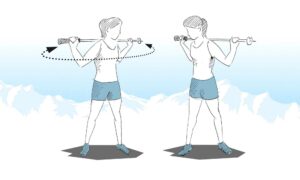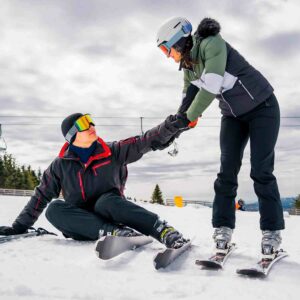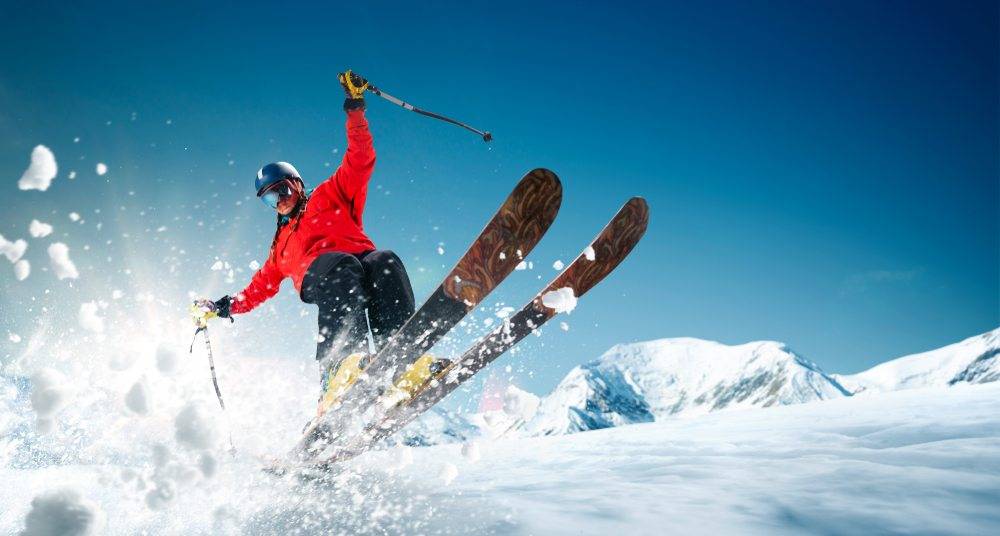Skiing is a popular winter sport enjoyed by many people. However, it can be dangerous, and injuries are common. One of the most common injuries is to the knee. In this blog post, we will discuss some prevention tips for skiing-related knee injuries. If you follow these tips, you can help reduce your risk of injury and have a safer skiing experience!
Contents
What Are Skiing Knee Injuries?
 Skiing is a high-impact sport that can put a lot of strain on the knees. The sudden stops, sharp turns, and fast speeds can all lead to injuries. Skiing knee injuries are some of the most common ones that occur. In fact, it’s estimated that about 25% of all skiing injuries are to the knee.
Skiing is a high-impact sport that can put a lot of strain on the knees. The sudden stops, sharp turns, and fast speeds can all lead to injuries. Skiing knee injuries are some of the most common ones that occur. In fact, it’s estimated that about 25% of all skiing injuries are to the knee.
There are a few different types of skiing knee injuries that can occur. The most common ones are:
- An anterior cruciate ligament (ACL) tears: This is an injury to one of the main ligaments that stabilize the knee. It’s estimated that ACL tears account for about 50% of all skiing knee injuries.
- Medial collateral ligament (MCL) tears: This is an injury to the ligament that stabilizes the inner part of the knee. MCL tears are less common than ACL tears, but they can still occur.
- Patellar tendon tears: This is an injury to the tendon that connects the kneecap to the lower leg. Patellar tendon tears are relatively rare, but they can still occur.
The causes for this type of knee injury generally fall into one of three categories:
- Overuse: This is the most common cause of skiing knee injuries. Repeated stress on the knees can lead to tears in the ligaments or tendons.
- Trauma: A traumatic event, such as a fall or collision, can also cause skiing knee injuries.
- Mechanical problems: If your ski bindings are not properly adjusted, it can put extra stress on your knees and lead to an injury.
How To Prevent Skiing Knee Injuries?
There are various ways in which you can prevent skiing knee injuries. Some of the most important tips are as follows:
Wear The Right Gear
One of the most important things that you need to do in order to prevent skiing knee injuries is to wear the right gear. This includes wearing boots that fit well and provide proper support to your feet and ankles. You should also wear knee pads to protect your knees from impact in case you fall.
For example, if you are a beginner, it is important to choose a pair of skis that are not too long or too short. This will help you maintain your balance and prevent falls. In addition, you should always wear a helmet to protect your head in case of a fall.
Warm Up Before Skiing
 Another important tip to prevent skiing knee injuries is to warm up before hitting the slopes. A good warm-up routine should include some basic stretches as well as a light cardio workout. This will help increase blood flow to your muscles and reduce the risk of injury. There are some exercises for a good warm-up like:
Another important tip to prevent skiing knee injuries is to warm up before hitting the slopes. A good warm-up routine should include some basic stretches as well as a light cardio workout. This will help increase blood flow to your muscles and reduce the risk of injury. There are some exercises for a good warm-up like:
- Heel slides: Sit on the ground with your legs straight out in front of you. Slowly slide your heel towards your buttock, then back to the starting position. Repeat 10 times on each leg.
- Hamstring curls: Lie on your back with your legs straight and place a towel around your ankle. Slowly bring your leg up towards your buttock, then back to the starting position. Repeat 10 times on each leg.
- Inner thigh squeezes: Sit on the ground with your legs apart and place a small ball between your knees. Squeeze your knees together for 5 seconds, then release. Repeat 10 times.
- Calf raises: Stand with your feet hip-width apart and place your hands on a wall or chair for balance. Slowly raise up onto your toes, then lower back down. Repeat 10 times.
- Jumping jacks: Start by standing with your feet together and your arms at your sides. Jump up and spread your legs out to the sides, then back to the starting position. Repeat 10 times.
Stay Hydrated
It is also important to stay hydrated when skiing. This means drinking plenty of fluids throughout the day, even if you are not thirsty. Dehydration can lead to cramping, which can put you at risk for a knee injury. It is also believed that dehydration can make it more difficult for your body to repair itself after an injury, so it is best to avoid it altogether.
Learn Proper Technique
Skiing is very technical, and if you don’t have proper form, you’re more likely to get injured. Make sure you take lessons from a qualified instructor and practice regularly so that your technique is sound. And if you are a beginner, start on easy slopes before progressing to more difficult terrain.
For example, you can try the following drills to improve your skiing technique and reduce your risk of injury:
- Try doing a “pizza” stop where you dig in both edges of your skis at the same time to slow yourself down. This is a basic skill that all skiers should master.
- If you’re more advanced, try skiing with one ski pole. This will help you develop proper body positioning and balance.
Strengthen Your Body
It is important to have strong muscles around your knee in order to help prevent skiing-related injuries. Try doing some squats and lunges on a regular basis to help keep your muscles strong. Because when your muscles are strong, they can help take some of the stress off of your joints. For example, if your quads are strong, they can help take some of the pressure off of your knees when you are skiing.
Stick To A Comfortable Terrain
When you are just starting to learn how to ski, it is best that you stick to comfortable terrain. Once you have mastered the basics of skiing, you can then move on to more challenging slopes. A comfortable terrain is about finding a balance between being able to challenge yourself without putting your body at an increased risk for injury.
Stay on marked trails
It is important to stay on marked trails when skiing in order to avoid potential hazards that could lead to a knee injury. Hidden obstacles such as rocks and tree stumps can easily cause a fall, resulting in serious knee injuries. So, you should always be aware of your surroundings and only ski on trails that are designated for skiing.
Listen To Your Body
 Finally, it is important to listen to your body when skiing. If you are feeling pain or discomfort, take a break. It is better to rest for a few minutes than to push through the pain and risk an injury. And even rest is one of the best things you can do to prevent knee injuries. If you are skiing and your knees start to hurt, take a break, ice them, and see if the pain goes away. If it does not, it is time to see a doctor.
Finally, it is important to listen to your body when skiing. If you are feeling pain or discomfort, take a break. It is better to rest for a few minutes than to push through the pain and risk an injury. And even rest is one of the best things you can do to prevent knee injuries. If you are skiing and your knees start to hurt, take a break, ice them, and see if the pain goes away. If it does not, it is time to see a doctor.
Following these simple tips can help reduce your risk of sustaining a skiing knee injury. However, it is important to remember that no matter how well you take care of yourself and your equipment, accidents can still happen. If you do injure your knee while skiing, it is important to see a doctor as soon as possible. Early diagnosis and treatment can help you heal quickly and reduce your risk of long-term complications.
Conclusion
In conclusion, skiing knee injuries can be prevented by following some simple tips that are discussed above. By taking the necessary precautions while skiing and being aware of the risks associated with the sport, you can help prevent serious knee injuries.
If you are worried about sustaining a knee injury while skiing, talk to your doctor or a physical therapist who can assess your risk and offer specific exercises to help reduce your risk. With proper preparation and safety measures, you can enjoy a safe and fun skiing experience while minimizing your risk of a knee injury.
Consider Physical Therapy which has always been proven to help patients recover from pain. Hence, if you’re experiencing Back pain, Shoulder pain, Knee pain, Neck pain, Elbow pain, Hip pain, or Arthritis pain, a physical therapist at MantraCare can help: Book a physiotherapy session.


